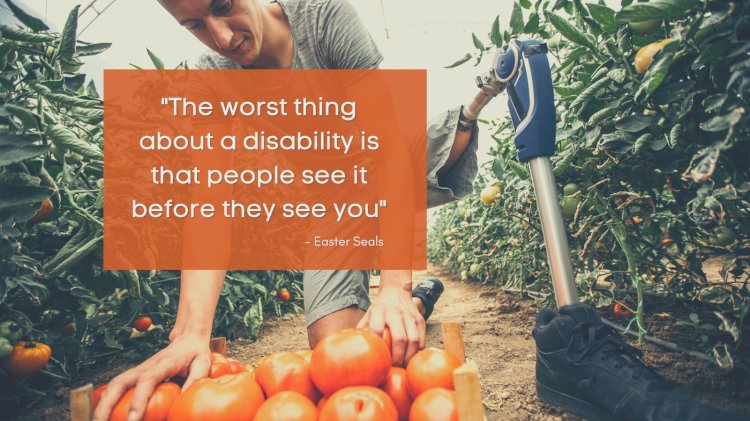It’s dignity, not just a welfare measure which is needed for PWD
The governmental schemes targeting People with Disability (PwD) appear to be facing severe intellectual and locomotive disability. They hardly focus beyond social security and welfare measures. Dr. Basavaraju R Shreshta of GRAAM explores the intricacies of PwD unemployment in two districts of Karnataka.

It was 2011-12, I was touring the united Andhra Pradesh on a mission to develop a Strategy Document for Karnataka State Rural Livelihood Mission. Since then the Society for Elimination of Rural Poverty (SERP) and Kudumbashree initiatives are considered as the models for the National Rural Livelihood Program. I decided to visit respective states to study those programs in action and for the better understanding of its minutiae. I also visited a neighbourhood group formulated under SERP’s pilot program in Gorantla mandal of Anantapur District during my mission. The group was established to serve as a multipurpose centre to federate, educate, empower as well as to provide required therapy for the People with Disabilities (PwD) in the mandal. While interacting with the members of the group, I asked a person how she feels in her not-so-remunerating job of book keeping for the SHG in the village. And whether it makes any difference in her life. Her answer still resounds in my ears. She said, “I was addressed as kunti (lame) by most of the villagers without even bothering to know my name. Today, I am recognised as an accountant and people address me by my name. The dignity this job has earned is more important than the money this occupation gives me. Now I have an identity”. There was a deep silence in the room following her words, and then there was a sudden eruption “Yes, dignity is more important than our earning”. This reminded me of a famous quote by Easter Seals "The worst thing about a disability is that people see it before they see you.” Unfortunately, this continues to be true even today.
As ironic as it sounds, many of the schemes developed for PwDs appear to be facing severe intellectual and locomotive disability. They hardly focus beyond social security and welfare measures. Our Government sincerely intended to get this disability out by opting in ‘empowerment’ in place of ‘welfare’ in the name of the concerned department. It seems there was a lack of understanding in recognising the need of a severe and systematic ‘occupational therapy’ to overcome the decadal disability in planning foresighted programs.
Employment status of PwDs
According to the 2011 census, the workforce participation rate of persons with disabilities is as low as 36.34 %. The employment rate for PwDs fell from 42.7% in 1991 (World Bank, 2007) to 36.34% in 2011. These figures are disturbing when considered in the context of India’s booming economy across a similar period. A well-known survey conducted in 1999 by National Centre for Promotion of Employment for Disabled People (NCPEDP, 1999) reveals that the rate of workforce participation of PwDs in the public sector is 0.54 %; private sector: 0.28 %; and multinationals: 0.05 %. Unfortunately this data has not been updated since the last NCPEDP survey, showing lack of thrust for building evidence in the disability sector.
In 2018, GRAAM conducted a study to understand ‘Employment Needs and Opportunities for PwD in the rural areas of Mysore and Gadag’. As much as 87.5% of the PwDs were found unemployed and interestingly, unemployment was proportional across different disability types. The annual family income of 72% of PwDs (among randomly selected samples) was in the range of INR 5000 to 25000. A strong opinion also rested with the families of the PwDs that the PwDs would not be able to lead a normal life. These 72% of the families were observed to be either unwilling or discouraging of PwDs pursuing education. On the other hand, 45 per cent of the families were ready to send the PwD members for any kind of employment.
The lack of education and training is a major barrier which hinders persons with disabilities living in rural areas from entering the labour market. The study found an insignificant relationship between the education and employment status of PwDs. 84 percent of PwDs were unaware of employment opportunities and 92 percent of the PwDs were not aware of the skills required for availing the employment opportunities. The other inference from this study was that the PwDs in rural areas have more employment challenges due to lack of access to skill training centers, rehabilitation centers and other required assistance.
Reach of Welfare Measures and Inclusion:
On 03 December 2020 we celebrated the International Day of Person with Disability. The theme this year by the United Nations - “Building Back Better: toward a disability-inclusive, accessible and sustainable post COVID-19 World”, got submerged amidst the pandemic chaos and arising shift in priorities as a result. In the recent study ‘Lock Down and Left Behind’, NCPEDP reported how persons with disabilities in India have been affected by the COVID =–19 crisis. PwDs had a huge challenge in accessing essentials such as food, clothing, shelter and medical support.
We still have large grounds to cover in reaching the basic welfare measures. It was found that nearly 15% of the PwDs did not have the disability card owing to the lack of awareness or lack of knowledge on how to obtain the disability cards, apart from the due financial constraints. Only 22 percent of the PwDs had MGNREGA job cards, while the other 88 percent of the PwDs were not even part of the scheme.
Many studies have informed that lack of effective financial inclusion is also a factor that hinders the differently abled in rural areas from seeking employment. Generally, banks consider persons with disabilities as bad re-payer. Even SHGs of the differently abled find it difficult to obtain loans from banks, and have reported unwelcoming attitudes by most bankers preventing them from even opening bank accounts. Most Gram Panchayats do not provide facilities as stipulated by the Government under various schemes. PwD is not even in the radar of PRI and does not keep a proper count. Such factors make disabled the marginalized amongst the marginalized.
Community Perception and Involvement:
Even today, a substantial number of families are not ready to reveal the disability with the larger community. Therefore, the PwDs refrain from interacting outside their homes. Accordingly, PwDs themselves do not tend to associate or participate in community activities. Non-participation in SHGs and other social platforms explains the absence of a social capital available for them. This can also be associated with their lack of awareness about employment opportunities. Our studies have revealed that only 9.5% of the respondents were members of at least one SHG. 63.5% of them were not involved in active interaction with any social groups. Villagers are unaware of any skill development programmes conducted in their village in general. Participation of PwDs in the Panchayat elections was also observed to be very rare.
Livelihood Interventions: Concrete Steps
There is a need to begin with Behavioural and Attitudinal Change among PwDs and their family. For the PwDs who are not educated and are above the age of 40 years, forming and promoting PwD self-help groups (family members in case PwD cannot take an active role) for livelihood activities are an appropriate option. A livelihood activity must be introduced after the group attains some maturity and ready to invest its share for the activity (after two years, or depending on the group assessment). Some of the group activities such as packing of FMCG products, producing some niche products which are artistic and outsourced business from the nearby industries can be explored. For the PwDs who are below 30 years of age and literate, wage/salaried employment in the service sector or related companies can be explored. Self-Employment or Process Outsourcing Employment Model should be developed as most of the PwDs are interested in home-based employment.
Vocational counselling should be provided to align the disability to the type of employment, so that it would rather be a strength for that job than be a limitation. The western model of ‘transition support’ is worth adopting to augment the ability of PwDs to join the workforce.
Gram Panchayats, Personnel of Department of Empowerment of PwD and Rural Livelihood Mission should work in collaboration to provide an action plan for creating employment opportunities in the rural area. The information on employment opportunities for the PwD should be delivered to the intended beneficiaries.
A specific support group of PwDs should be created at the gram panchayat level, where it would be available to respond to the needs and queries of the PwDs and their families. This group should be well-equipped to provide counselling facilities to the PwDs, their families and also the panchayat officials so as to engage in providing an inclusive and equal approach towards persons with disability. This group should also engage in sensitizing the PwDs towards widening their aspects of working in collaboration with the society.
The encouraging measures by Union Government such as 4.75 percent of the PF share from the employer is exempted and there is no limit of salary for availing ESI benefit for PwDs is seldom known by the employers. The government needs to take appropriate measures to reach out to the employer community, especially in the private establishments.
Entrepreneurial skills should be imparted for PwDs such that they can start home-based and product-based vocations such as making agarbattis, weaving of bags, food processing, etc. The training should also provide leads to availing financial aids through schemes like MUDRA, PMEG, CMEG that encourage secured entrepreneurship, additional interest subvention and longer repayment tenures for the PwD entrepreneurs. The government should also explore other Group Employment Models such as Mobile work crews, Enclaves and Sheltered Employment as appropriate to the local context.
A true empowerment needs to happen in an enabling ecosystem where PwDs are made to earn their dignity. A sustainable livelihood option facilitated by a strong human and social capital development should be the focus of our disability policies and programs. Only then can we expect to build a disability-inclusive, accessible and a sustainable world.
_____________________________________________________________
(The author is a Policy Researcher in the areas of Skill Development and Livelihood, and the Executive Director of GRAAM, a public policy think-tank and a former fellow of Employment and Disability Institute, Cornell University, USA)
What's Your Reaction?



















